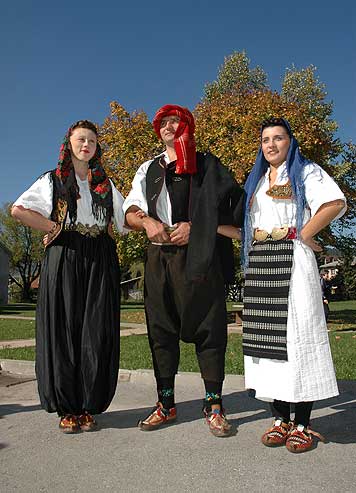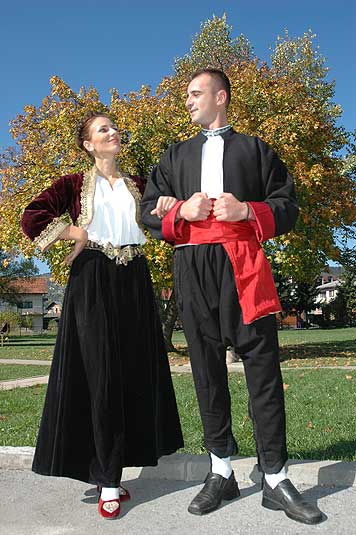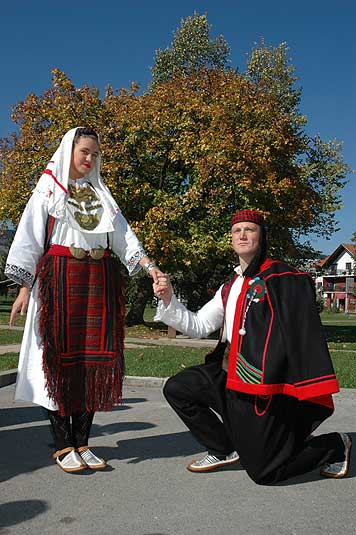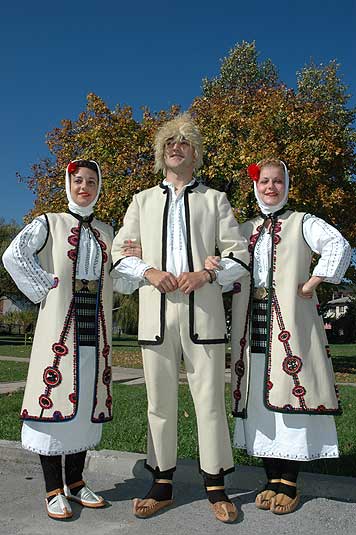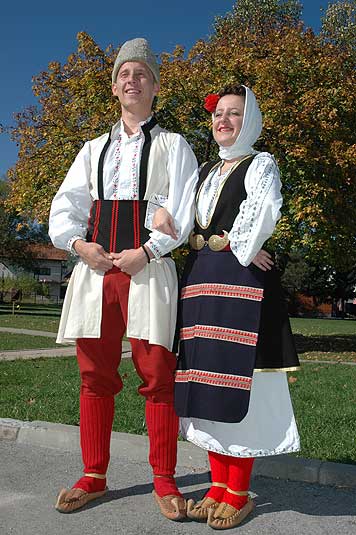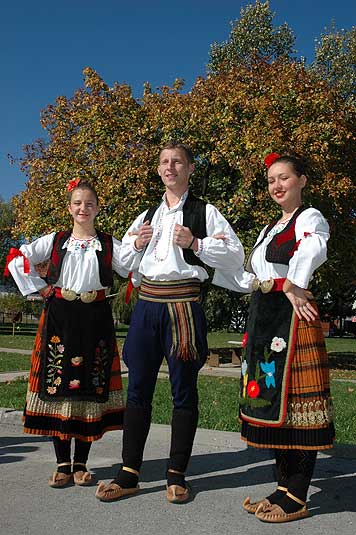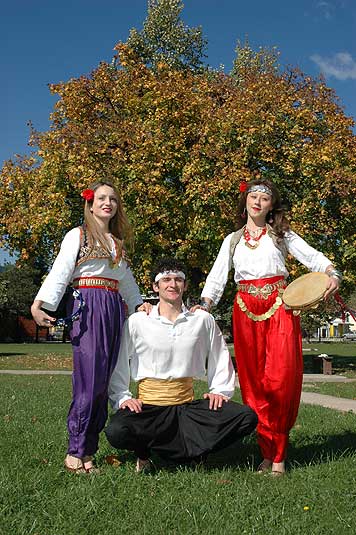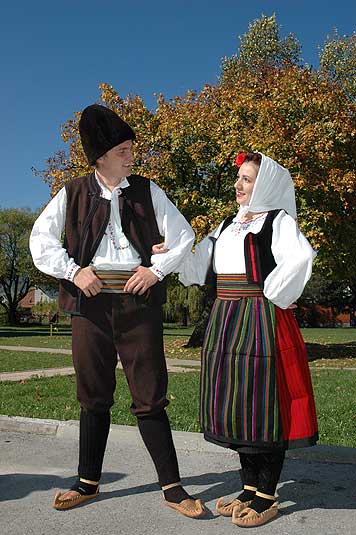The repertoire of the folklore ensemble "Mladost" - Pale
FOLK DANCES OF THE SERBIAN POPULATION FROM SARAJEVO REGION
Choreography: Vladimir Mandicevski
Time length: 10 min
Costumes: Both women and men costumes are original regional peasant clothing of the significant ethno value. Women wear dzecerma (home-made relief linen shirts), curdia (richly embroidered vests) and long white dresses. Their heads are covered with cenar (colorful kerchiefs). Men have slightly different type of shirts and vests, black trousers made of heavy cloth and embroidered cap, called krmez. All of them wear the characteristic type of peasant leather shoes (opanak).
Women start the folk dance with kolo (characteristic dance, where the dancers are in a row and following the direction of the dancer who is the first one, often forming the circle) and singing “Trebevicu, visok tefericu, s tebe mi se vidi Sarajevo…’’
These dances are very dynamic and one has to use the entire body to follow the rhythm. They were performed during certain holidays, weddings or gatherings. Some dances were performed equally in the rural and urban areas.
There are several types of these characteristic dances, better known as kolo, in this choreography, – Osmerac, Sarano, Poskakusa, Cuca, etc. During Dirlija dance, one male dancer loudly sings, following the rhythm, the next lines – “Dirli dirli dirlija, ozeni se Ilija…” as the tempo increases. Most of the dances are followed by pleasant traditional song, as “Cuvam ovce na livadi sama, slusam pjesmu mojega dragana” or “Milica je vecerala, pa na sokak istrcala, da vidi svoga dragoga”.
THE SERBIAN SONGS FROM SARAJEVO
Choreography: Jelena Dopudja
Stage production: Mladen Krsman
Time length: 10 min
Costumes: Original costumes of Serbian city dwellers from Sarajevo, with preserved national and religious authenticity. Women wear long black plush skirts, white embroidered shirts under richly embroidered vests (libada), belt around waist (pafta) and adorned high-heel slippers. Men’s costume consists of white shirts and gunj (type of long jacket lined with fur), black trousers and black shoes.
The main characteristic of these dances are elegant and refined short steps, combined with slow body swinging, which gives them a particular charm. There are open and closed kolo dance in this choreography and a lot of songs with the humorous lines.
The names of these dances are: Jeftanovicevo kolo, Igra kolo na cekicu, Sarajcica, Daj to maj to, Dudjun pop, etc.
OLD BOSNIAN "MUTE" KOLO FROM GLAMOC AREA
Choreography: Vladimir Mandicevski
Time length: 8 min
Costumes: Traditional Serbian peasant clothing. Men’s costume consists of wide dark-blue trousers (caksire) made of coarse fabric, shirt, adorned waistcoat made of thin red cloth with black embroidery on the front (dzemadan), long gunj (type of long jacket lined with fur) hemmed with red cloth and adorned with red rose made of wool and authentic cap with fringes. Women wear home-made linen shirts (that shirt is from neck to ankles long), dark-blue short-sleeved or sleeveless jacket made of heavy cloth and embroidered on the back (sadak or zobun), massive necklace on their breasts, usually made of large silver or gold coins (gerdan or zveke). The jingling of that necklace establishes the rhythm of a dance. On their heads they have white kerchiefs decorated with red stripes.
This is the most characteristic dance from the harsh mountain’s regions, without musical background. The girls start the kolo. Rhythm is given by sound of steps and the jingling of the necklaces. The leader of a kolo gives commands quickly and loudly, urging frequent changes during the dance. The men dance is dominant. This is the tempo of strong highlanders, who were through difficult dance and strong hand-shaking used to check endurance and health of the girls. The girls express submission and modesty by small, quick steps and through non-showing of any sign of fatigue.
THE FOLK DANCES FROM THE EASTERN HERZEGOVINA – GACKO REGION
Choreography: Vladimir Mandicevski
Time length: 8 min
Costumes: Traditional Serbian peasant clothing. Women wear home-made linen dresses with darker embroidery around sleeves, weaved fringed apron, dark-blue zobun made of heavy cloth hemmed with dark-red narrow stripes and a cap on the head. Men’s costume consists of white trousers, long gunj, dark-red weaved belt and also a cap on the head.
All of them have the same footwear – characteristic type of leather peasant shoes (opanci), fastened with strings.
One part of the dance is performed without singing, and the other part has a lot of vocal background. There are a number of varieties in the performance. There are several types of kolo dances, including two-level kolo, so called kolo na kolo. The important remark is that during the kolo, observer can often notice discord between dance and vocal background. The types of kolo differ by the pace, tempo, number of rows… Their names are Jednovito kolo, Prolijeta, Proskaka, Kolo na kolo, Trusa, etc. Songs are: Tekla voda na valove, Kalopere- pere, Kiceno, kiceno nebo zvijezdama, Oj djevojko, etc.
VLACH’S FOLK DANCES
Choreography: Desa Djordjevic
Time length: 8 min
Costumes: Original costumes from Vlach region with characteristic high shaggy fur caps (subara), natural-white zobun (short-sleeved or sleeveless jacket made of heavy cloth) with black stripes on borders and coarse cloth trousers.
Women also wear zobun, but with more adornments, white dresses with fine black embroidery and white kerchiefs around their heads. All of them have opanak as footwear.
The Vlachs are one of a few nations in the world who have their language, but not an alphabet. Nevertheless, they manage to preserve their rich folklore and tradition through dance and song. The folk dance has musical background, and it is very temperament and attractive. Its main features are fast syncope-steps, comical and theatrical moves, and occasionally, vocal background and rivalry of the dancers during dance.
THE FOLK DANCES FROM PIROT
Choreography: Desa Djordjevic
Time length: 8 min
Costumes: Original costumes of the Eastern Serbia, richly decorated. Men’s costume consists of natural-white zobun, black-red belt, black or red trousers and subara (characteristic high shaggy fur cap) on the head. Women wear white dresses under black zobun, which hasgold stripes on borders, decorated aprons and white kerchiefs around their heads. On their feet they wear red socks and characteristic type of leather peasant shoes (opanak).
There are only a few regions which have such high tempo and speed in folk dance as the Eastern Serbia. That type of folk dance is a challenge for a choreographer, and it is very attractive. The names of dances are: Posla rumena, Pirotsko momceto, Lile, lile, Sestorka, Sopske, Stara planina, etc.
THE FOLK DANCES FROM SERBIA
Choreography: Vladimir Mandicevski
Time length: 9 min
Costumes: Original richly decorated and embroidered costumes. Women wear black-red weaved skirts, adorned with small plisa (a type of adornment), weaved decorated aprons, home-made linen skirts and small dark-red sleeveless embroidered jackets (jelek). On the sleeves of their shirts there are several red ribbons. Men’s costume consists of dark-blue trousers, colorful cloth and dark jelek over white shirt. All of them have the same footwear – characteristic type of leather peasant shoes (opanci), fastened with strings.
The dance is full of joy, songs, shrieks and colors. The main characteristic of this choreography is frequent change in rhythm and rivalry of the dancers during dance.
The names of dances are: Kolenike, Carlama, Sumatovac,etc. Songs are Mala basta…
THE FOLK DANCES FROM VRANJE
Choreography: Desa Djordjevic
Time length: 12 min
Costumes: Original costumes – a mix of the local tradition and oriental influence. Men’s costume consists of dark trousers and gunj with red stripes at the end of its sleeves, red silk belt and the black shoes. Women wear black plush skirts, white blouses and highly decorated libada embroidered with gold srma, pafta around waist and tepeluk on the head.
The Vranje dance is recognizable by its dignified style with a touch of pride and desire. Women are more reserved and men have more freedom to improvise. In the recent time, when there are more brass bands as background, the tempo is slightly higher.
The names of dances are: Tesko oro, Vranjanka, and songs are Iz banju ide, Presevka, Pembe. The finale is a dance of merry Gypsy girls, who use to entertain the people from Vranje and lure them to join their celebration and dance. This is choreography which preserved authenticity and satisfy all stage requirements.
THE FOLK DANCES FROM LESKOVACKO POMORAVLJE "STANI RADO, BELA RADO"
Choreography: Milorad Lonic
Time length: 10 min
Costumes: Original costumes from Leskovac area. Men’s costume consists of dark trousers, cloth, white shirt, dark jelek (a small dark-red sleeveless embroidered jacket) and black subara (characteristic high shaggy fur cap). Women wear weaved skirts (fute), colorful aprons, white embroidered dresses, dark jelek and white kerchiefs around their heads. All of them have opanak as footwear.
Many rituals from Leskovac area were preserved. Music and dance have a very important role. Stani rado, bela rado is a mix of dances, songs and harvest customs from Leskovacko Pomoravlje area. It begins with entrance of girls with lighted candles who sing Zadji sunce ne zaslo ga, then follows the dances: “Vlasinka”, “Cacak”, “Ljubovno kolo”,“Bugarka”. Additional songs are “Grabajte, da grabamo”, “Devojce, devojce”, “Ide Jovo od oranje, bela rada od kopanje, stani Rado, bela rado, daj da ljubim lice mlado”…
Latest news
-
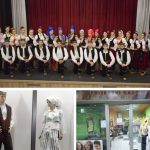
КУД ,,Младост” Пале обиљежио 67 година постојања
У жељи да се умјетност и култура сачува и у ври... -
КУД ,,МЛАДОСТ“ ПАЛЕ ЈОШ ЈЕДНОМ ПОЛОЖИО ТЕСТ ХУМАНОСТИ
На хуманитарном концерту који су у облику јавне... -

Фестивал културног насљеђа – Абу Даби, децембар 2019.
Чланови извођачког ансамбла су представљали Бос... -
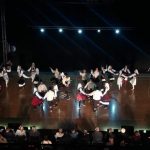
Прослава 65 година рада
22.11.2018. године одржан је јубиларни концерт ... -

,,Мир на Балкану”, Дупница, Бугарска
Међународни фестивал фолклора ,,Мир на Балкану”...


